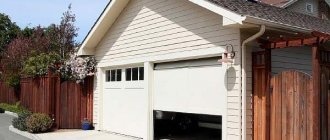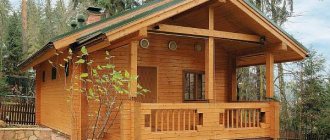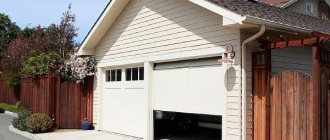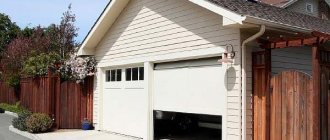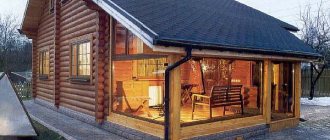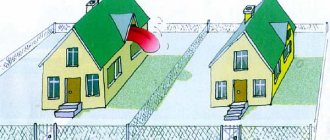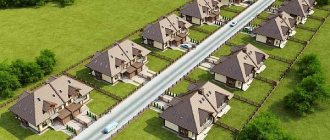Owners of private houses are faced with the need to complete and rebuild outbuildings according to their needs. The main condition for the further trouble-free operation of such buildings will be the regulatory regulation of the location in accordance with construction rules. To find out all the nuances associated with planning and building a garage extension, our article has selected answers to many thematic questions. So let's answer the question at what distance from the fence you can build a garage.
Site planning
Of course, the owners of new buildings were extremely lucky, because construction, as a rule, was carried out taking into account all existing standards. If there are already buildings on your site, and now the question of moving or building new ones has arisen, it is imperative to study the legislative framework regarding the distances between buildings.
General provisions for placing objects on a land plot:
- The distance from the residential building to the fence should be 3 meters or more. If there is a utility room attached to the house, it is necessary to count from it. The minimum distance between residential buildings is six meters.
- When constructing outbuildings, it is necessary to retreat at least a meter from the nearest fence. If the roof slope has a wide span, it is necessary to calculate the distance from it. If these conditions are not met, the neighbor can file a lawsuit and force the building to be demolished or rebuilt.
- The minimum distance between adjacent buildings must be at least six meters. By mutual agreement of neighbors, this parameter can be reduced, but problems may arise with architectural institutions and further paperwork.
- Buildings intended for keeping domestic animals must be located at least four meters from the fence. The optimal distance to a residential building will be 15 meters, but in reality this parameter is very difficult to maintain due to limited space.
- Sanitary facilities, such as toilets, showers and baths, are considered potentially dangerous sources of groundwater contamination. Their location should be no closer than 2.5 - 3 meters from the neighboring fence. This rule can also be applied to silo pits, but it will be difficult to prove anything in case of claims; it is better to resolve such nuances amicably.
- Gazebos must be located at a distance of three meters from the main building. If we are talking about a temporary summer version of a collapsible structure, it can be placed at a meter distance from the fence and buildings. If the gazebo is also equipped with a fireplace or barbecue, the distance from the residential building must be at least ten meters.
- Summer kitchens and greenhouse structures must also be located at least a meter from any buildings. These requirements will help not only comply with regulations, but also make further operation comfortable.
- Perennial plantings should also not be located chaotically. Regulated standards for shrubs require a distance of at least a meter from the neighboring fence. For short trees this is two meters, and tall plantings must be planted at a distance of at least four. A growing crown will not reduce this figure, since the calculation is carried out from the center of the trunk.
Of course, minor deviations from these standards are possible. As a rule, such issues are resolved with mutual consent of the owners of neighboring plots. Do not forget about fire safety, for example, it is necessary to maintain the specified distance between houses. In the event of a fire, there is a high risk of the fire spreading to neighboring buildings, so this is a very sensitive issue. Some aspects of the location of the garage building are discussed below.
What standards must be followed?
At what distance from the fence is the garage - provided by SNiP. Its instructions are in the nature of recommendations, which the court is guided by if complaints arise from neighbors. Construction standards must be observed in two directions if it is made permanent: under a roof and with a foundation.
If the roof extends beyond its limits, then the distance is calculated not from the foundation, but from the end of the roof. The basic requirements are as follows:
- fire safety, which the owner now controls independently, because the state has removed one-story buildings from its control;
- compliance with mechanical safety standards, which consist in the impossibility of the existence of a building or part of it that can cause mechanical damage to buildings or people;
- compliance with environmental safety standards: toxic materials that could cause potential harm to the environment or people living nearby cannot be used for construction;
- compliance of the building with climatic standards. If there is a possibility of natural disasters, then it is certainly taken into account in the nature of individual housing construction or any other structure, be it permanent or temporary;
- According to the rules, no residential or commercial structure should infringe on the interests of other people. In this particular case, it concerns the neighbor's property.
In order to obtain permission to build a permanent garage on his own site, the owner of the future automobile structure must comply with specific conditions developed specifically for the target buildings. As for the permit, it will still have to be obtained during the registration procedure, which became a mandatory condition in 2021 in addition to the capital structure.
Allowable distances
The distance from the fence to the garage is an important, but not mandatory condition of SNiP in 2022. The norm for the distance to the fence can be circumvented if there is a notarized written consent of the neighbor to erect the building. It can appear in court, even if the owner of the site has changed, and the new one does not like what is already there. But there are other rules that you need to know.
Detached garage
The most popular and traditional option is that the garage is separate from the residential building. It can combine additional functions: a basement, a workshop or utility rooms for storing tools. If this is your case, do not ignore some important aspects of placement on the site.
Basic moments:
- To erect a building, it is advisable to use the northern side, an unused plot, or simply a plot of land that is optimal in location.
- When combining a garage with other outbuildings, it is necessary to consider two separate entrances that do not communicate with each other. To do everything in accordance with the letter of the law, the distance between entrances must be at least seven meters.
- To build a garage, you must choose a site on an elevation (natural or specially created). This will protect the building from flooding and help make a suitable entrance.
- Melt water should only be drained onto your own site. If the canopy of a building exceeds half a meter, the distance to the adjacent fence is measured from its projection.
- If there is already any structure on the neighbor’s property, the location of the garage must be at least five meters away from it. How you can reduce this distance is described a little further.
Is it possible to build a garage on the boundary line? This issue is discussed in detail in further information. If we are talking about a permanent structure, be sure to make such changes to the official site plan. This will save you from many bureaucratic problems in the future and will allow you to feel confident in any situation. You should also not ignore maintaining the required meter between the fence and the building. Even without taking into account possible problems with neighbors, this distance will help in the trouble-free operation and maintenance of the building, for example, when performing external insulation or painting.
Indents and standards
The location of buildings and outbuildings on the owner’s property, according to changes made to the legislation in 2018 and which came into force in January 2021, should be planned in advance, even before the start of fencing the border of the property.
Garage on a private housing plot
The construction of a fence is possible only with obtaining the appropriate permit, after the boundary has been determined and legally fixed by special organizations.
Fixing the property boundary with a fence is the direct responsibility of the owner. Even if one of the parties does not come into contact with the neighbor’s property, roadway or territory of public institutions.
Installation of a fence along the border of the site is carried out with the permission of local authorities. The layout of the land being built should be determined from the constructed fencing.
Garage at the dacha
To obtain the government permission required in 2021, when drawing up a development plan, you will have to take into account many requirements enshrined in official documents:
- SNiP, compiled back in the days of state construction on the basis of rich theoretical experience. Some of them have been revised and supplemented, and there is an updated edition.
- The set of rules - SP, was adopted after the revision of SNiP. For example, SP 53.13330.2019 is nothing more than SNiP 30-02-97, brought into line with the norms of modern legislation and taken into account when making changes.
- SanPiN is necessary to bring it into compliance with sanitary standards.
- PZZ – land development rules. They must be taken into account when building car garages within the city, taking into account the distance to public and medical institutions, industrial buildings and communications - gas pipelines, power lines, heating mains, as well as other structures and structures.
- Fire requirements, which specify minimum fire distances, help determine the required fire safety.
- The Code of Administrative Offenses contains a clearly developed system of sanctions and fines. These are measures to prevent violations if construction is not carried out in accordance with the law.
Garage next to the red line
Subtleties
The fencing of the site boundary, according to cadastral measurements, begins only after receiving permission from the supervisory authorities. A development plan drawn up in accordance with the requirements of all documents at the legislative level is beyond the power of a person without special legal knowledge.
Garage in the architecture of a residential building
This option is typical for European and American residential buildings. At the same time, it is very convenient and practical, which is why new buildings, even multi-story ones, are often designed this way. The basement or “zero” floor is allocated for the garage space, and the entrance is located on the side of the facade where there is no central entrance. This arrangement has its advantages and disadvantages, but it is important to think through other important details.
Important nuances of the built-in garage option:
- The room should not be connected to living rooms. The option when purchases are unloaded directly into the kitchen is very tempting, but has a number of disadvantages, for example, exhaust gases entering the living space.
- It is advisable not to plan a bedroom or nursery above the garage. This is difficult to do, because we try to make maximum use of all the usable space. At the same time, these are fire safety requirements, so compliance with them will not be superfluous.
- Supply and exhaust ventilation is a must! In this case, it is best not to rely on natural air circulation, but to install a small fan-type device at the ends of the ventilation pipes. This will significantly improve the quality of ventilation, and also make this “neighborhood” with the living space safe and comfortable.
- The entrance to the garage must be located at least a meter from the fence. It would be useful to repeat the rules for the location of the garage in relation to the “red” line, which are described below.
Before planning, it is imperative to check the groundwater level. This is done with special equipment at the stage of project creation, so additional modernization of an existing building requires extreme caution.
How to take into account the terrain
If the plot is flat, then the location of the garage will not matter. It is enough just to adhere to the established distances from other buildings. But if the area has complex terrain, then for construction it is better to choose a place that will be higher than the average height of the site. This way you can avoid flooding during spring floods, as well as constant dampness. It must be remembered that dampness will certainly lead to corrosion of the car, and it is much easier to prevent it than to deal with the consequences.
If the plot is up to 10 acres in size, then you don’t have to choose where to build a garage. In this case, it is necessary to raise the site for construction. To do this, you need to bring in several trucks with soil and carry out the leveling, making a flat area.
Attached garage space
In general, here you can also focus on the previous option. The entrance must be thought out so that the car does not turn anywhere, much less go around the house. In addition to rational use of space, this option is as safe as possible for loved ones and convenient for everyday use. The code does not specify the height of a structure, but complaints from neighbors about shading may result in litigation and scrutiny of other possible construction violations. That is why when planning it is necessary to take into account this important nuance.
Fire safety issues
The garage building is a source of increased danger. This is due to the fact that the car contains a flammable substance in the tank, and its leakage can lead to a fire. Owners often store fuels and lubricants in the garage, so these factors must be taken into account during construction.
In the room intended for storing the machine, there must be a fire shield with fire extinguishing tools installed on it:
- nightmare;
- fire extinguisher;
- shovel;
- gaff;
- box with sand.
Placing a garage on the “red” line
This term did not arise by chance; it is a kind of access zone to important communications: electrical wires, sewer pipes and water supply. This is a necessary condition for the normal functioning and operation of systems. Placing any objects on it can be regarded as a threat in case of emergency situations. The same rule applies to a car parked on the street, even temporarily. To avoid problems in the future, it is better to think about the issue of comfortable and safe entry into your territory.
If you pay attention, many car owners plan the location of the garage entrance directly from the street. This is very convenient and saves a lot of time and effort; in addition, on a busy street there may simply not be enough time to open and close the entrance gate to the territory, creating a traffic jam of other cars. The best option would also be to install a small ramp for entry and roller automatic garage doors. The described option is quite good, but if there are any communications directly outside your fence, the realization of this dream threatens serious troubles and financial costs.
The thing is that according to the law, it is necessary to retreat at least five meters from the red line. Such conditions are also often impracticable because a distance of at least three meters is also provided from the garage to the residential building. A little trick can save you: the entrance to the garage can be located at a meter distance from the fence border. Simple architectural tricks and the ability to create an individual parking zone will be a pleasant bonus. In the event of litigation, you can always point to that clause of the rules that requires the garage to be located at a meter distance from the fences. In this case, a canopy or additional canopy is not considered a reference point if this structure does not protrude beyond the boundaries of your own site.
An important point: red lines can be not only existing in reality, but also planned, for example, during gasification of this section. This will create certain difficulties with the construction of any buildings, so it is better to comply with the specified standards, even just “just in case.”
Building regulations
The standards for indentations during the construction of garages depend on several significant circumstances, which can be determined by studying the relevant SNiP. The garage, according to the current legislation of 2021, belongs to outbuildings. Therefore, official permission for its construction is not required. But this applies only to collapsible options, without a foundation.
Not far from neighbors house
The garage must be present on the plot plan because codes and regulations define distances differently. They must be observed in relation to the fence and buildings of the neighboring area. In this case, an indentation from the red line is necessary.
The garage attached to the house has its own characteristics and nuances. When using the rear wall of a building instead of a fence along the property line, compliance is taken into account.
Garage construction standards apply only to buildings on a foundation. But the distance from the foundation is taken into account only if the auxiliary building does not have a canopy or gutter for drainage. Then the required distance is measured from the projection of the protruding part onto the ground.
Setbacks from the boundary of the neighboring plot and the road according to SNiP standards
The absence of the need to obtain permission to build an easily dismantled structure does not mean that the setback dimensions do not need to be observed. Such a neglectful attitude can cause discontent on neighboring landowners, and then complaints to the authorities or lawsuits cannot be avoided.
Construction documents
The flexible system of legislation does not regulate exactly what must be provided before building your own garage. The best option is to find an intelligent architect associated with this field. Regulations may change even depending on the region of residence, so it is impossible to provide exact advice and instructions.
The following points can be highlighted:
- The construction of a garage on the site of an old structure already included in the technical passport does not require registration again.
- Modernization and any design changes must be agreed upon and also secured at the legislative level.
- The construction of a new residential and utility structure, as well as the installation of fences, requires familiarization of all neighbors and their written consent with your plan. If someone disagrees, this opinion must also be taken into account.
- Controversial issues regarding the placement of boundary boundaries and corresponding buildings must be resolved with the involvement of geodetic services.
- The simplest, but most expensive way is to order the layout of structures from an independent architectural organization. Of course, this will help solve many problems, but the cost of such services will be very significant.
- If construction work is underway on your property and on your neighbor’s property at the same time, it is important to agree on the location of the new facilities with the owner of the neighboring property. It would be a good idea to consolidate such agreements in a written agreement so that problematic issues can be challenged in the future.
This is probably the most difficult part of the future garage construction project. Often such litigation drags on for a long time, especially when it comes to controversial issues between the owners of neighboring plots. In this case, our advice can help, as well as compliance with basic standards for the placement of outbuildings on the site.
Types of garages
The main differences in the construction of garages lie in the choice of material from which they are built. This fact will also determine the operational characteristics, design and cost of the building. Most often when constructing a garage, the following materials are used:
- Steel sheets. They are used to make a welded all-metal structure. It is very easy to assemble, and the cost of such a garage is low. The downside is their sensitivity to climatic conditions: in winter they are cold, and in summer the iron heats up under the scorching sun, creating unbearable heat.
- Brick. A garage made of this material is a permanent structure. Accordingly, a foundation needs to be made for it, which significantly increases the cost and complexity of the structure. Often an inspection hole is placed in a permanent garage, creating a small workshop. In addition, you can arrange a cellar, turning the garage into a small utility unit.
- Foam block or cinder block. By themselves, these materials retain heat well, allowing you to make the garage warm, which makes it easier to start the car in the winter cold. But, as in the previous case, construction requires the construction of a foundation.
- Construction of a garage from sandwich panels. These materials allow you to create warm, lightweight structures. They do not require a strong foundation. Sandwich panels have a low thermal conductivity coefficient, so you can maintain a comfortable temperature in such a garage in winter and summer.
- Wood. If the garage will be used only for storing cars, then this choice of material is acceptable, but if you plan to carry out any repair work, you need to remember that wood, even treated with fire-resistant impregnations, is a source of danger.
Is it possible to build a garage on the border of the plot?
Often in old houses you can find this arrangement. Moreover, garages can also be double, when neighbors decide to build a joint building on the boundary dividing line. This is a good option that “works” only in the case of cloudless relations between neighbors, as well as a joint distribution of responsibilities for maintaining the structure.
Technically, this arrangement is possible, but there are some nuances. First of all, this is the written consent of the second party about the location of the building on “common” land. Even if it is received, do not forget about the possibility of force majeure.
“Pitfalls” of this option:
- The neighbors' written consent must be renewed every three years. After this period it is considered invalid.
- When the owner of the neighboring plot changes, the contract is automatically canceled, and it is still unknown whether the new owner will agree to such a decision.
- The heirs or even the significant other of the owner of the neighboring plot also have the right to terminate such an agreement.
- Structural changes to the architecture of the garage must also be agreed upon with the owner of the neighboring property.
As you can see, the location of the garage on the border of the site is fraught with troubles. In addition to legislative rules, there is a risk of being drawn into proceedings simply because relations between neighbors have deteriorated or any modernization of the premises will become impossible.
Recommendations for choosing a location for building a garage
When the owners have a large plot of land at their disposal, choosing a place for a garage will be easier.
It’s even better when the neighboring estate is being developed at the same time as yours.
In a small area the situation will be the opposite. Often you have to place a garage almost close to the fence. Here you will have to enlist the support of your neighbors in advance.
For proper placement, it is important to consider the following points:
- What kind of garage will it be: a separate structure or attached to a house or bathhouse?
- How will transport enter: directly next to the highway or through the yard.
- There should be no tall trees or dense bushes planted nearby.
- Parking in front of the garage door should be convenient. It is useful for washing the car, unloading things, disembarking passengers.
- There should be no utilities in the neighborhood.
- It is unacceptable to place a garage in a low-relief area of the yard.
Do not neglect the recommendations of SNiP and place the garage directly on the adjacent border of the plots. This is fraught with conflict, even leading to litigation.
The optimal distance to a residential building is considered to be 7 steps from the porch. But we must not forget about the red line. It may become an obstacle to such placement.
The red line corresponds to the external boundaries of the designed buildings. According to regulatory documentation, the minimum distance to the garage is 5 m.
On a corner plot, where one of the sides opens into a side passage, it is permissible to build a structure at a distance of 3 m.
The main thing is that the chosen location allows you to conveniently leave and enter the car and does not cause quarrels with neighbors.
Compliance with safety regulations
The construction of any outbuildings, and especially residential buildings, requires compliance with certain standards. First of all, what problems may arise with is coordination with fire services. It should be noted that these rules are important, first of all, for yourself, because it is safety and quick help in case of an emergency.
Important points:
- The distance between neighboring buildings must be at least five meters.
- An attached garage is considered part of a residential building, so the distance in this case should be at least three meters.
- A detached building is already classified as an outbuilding, so the standards here are a little softer (from one meter or more).
- The fire safety class is determined by the material of the building. Stone and brick buildings will receive the maximum rating.
- Electrical wiring must be carried out taking into account all requirements. Protective shades on lighting fixtures are required.
- Storage of fuels and lubricants also needs to be considered. For this purpose, special containers are used, hermetically sealed and without damage. If the garage has a technical cellar, it is best to use it for storage.
- It is better to place trees growing nearby at least three meters from the building. This will prevent further spread of fire in case of fire.
- If the building is not fireproof, it must be located at least ten meters away from residential and commercial buildings. This rule applies primarily to wooden buildings, as well as buildings made from scrap materials.
You can cheat a little and place the garage a little closer to the building on your neighbor’s property. We are talking about 2 - 2.5 meters, but these rules apply only if there are no heating devices or stoves in the garage, as well as in a specially equipped fire safety stand, which includes a fire extinguisher and a separate power supply switch.
Another option: when the site has a corner location, was not considered at all in the article. In this case, the location of the garage to the side passage must also be at least three meters. This will provide free access in case of emergency, and will also protect you from intruders. To make the building as safe as possible, it is also necessary to get rid of nearby trees.
The placement of a garage building requires mandatory approval, because there are many important nuances. First of all, we will talk about the required distance between the fences of the site, neighboring buildings and public communications. Our advice will help you do everything right, but it is also better to first coordinate your plan with the architectural organizations of your locality. There are many subtleties in this matter that only a specialist can determine.
Distance of the garage from other buildings
Taking into account the type of structures, they have differences in indicators.
fence
According to SNiP, the garage is classified as an outbuilding. The recommended distance to your fence is 1 meter.
It is recommended to make a distance of 6 m from the neighboring fence. Such a large distance is justified by fire safety standards, the risk of shading, and passing near communications.
Neighbor's garage
The permissible distance from any buildings, including a garage, on a neighboring site is 6 m. The same indicator remains the same regarding the distance of the garage from the neighbors’ house. At the same time, the garage structure should not create a shadow. Drains should only be placed towards your homestead.
Site boundaries
According to the standards, you need to retreat 3 m from the garage to the border of your own plot.
Roads
The distance recommended by law from the edge of the road to the garage door in the side passage is 3 m. From the side of the central highway to the building it should be 5 m.
The distance is calculated from the plinth with a protrusion, facade or roof of the garage.
Red line
The red line is usually called the outer boundary of construction projects that are located on the estate and included in the project. This feature separates the dacha plot from the highway.
In addition, the red line is the boundary of land allocation from the common:
- pipelines;
- power lines (power lines);
- cables, wires;
- communication lines.
The minimum distance from the garage to the red line is 5 m. When it comes to a residential street, the figure decreases to 3 m.
In individual housing construction (individual housing construction), this feature is necessarily depicted on the site diagram and is included in the design documentation.
The direction of the garage door (inward, outward) does not matter. It is important not to go beyond the red line.
Green spaces
Thematic material:
- What trees are planted along the fence?
- Distance from trees to neighboring fence
The distance indicator varies depending on the type of plant:
- from trees – 4 m;
- from bushes, medium-sized trees - 2 m;
- from plants, flowers – 1 m.
When choosing a location, you need to take into account that the structure can create shadows and interfere with the normal growth of plantings.
Residential building
In the private sector, the garage should be located at a distance of 3 m from the residential building. The distance is calculated from base to base of buildings.
Wooden buildings
According to SNiP in rural areas, in a dacha the garage should be 15 m away from the wooden residential building.
But the distance can be reduced to 6 m if the following requirements are met:
- Build a fire shield near the garage.
- Secure a fire extinguisher indoors.
- Position the electrical cable taking into account the PTEEP.
- Install fuses on meters.
- Wrap the electrical wires in a metal sleeve.
- Lay the electrical wiring so that it passes through the meter, which is located inside the house.
- Protect all lamps and fixtures in the room with shades.
- Do not install an electric heating system in the garage.
We recommend reading about fire safety standards in the section below.
Is it necessary to register a garage built on a summer cottage?
A garage in a country house is usually made in the form of lightweight, inexpensive buildings. This circumstance is due to the fact that a room for a car is needed only during the warm season, which means there is no need to erect a permanent structure. These can be metal or sandwich panel garages, the construction of which does not take much time and resources. What to do with registration in this case?
According to the law, garages, which constitute real estate, are registered. Light structures that do not have a foundation or can be dismantled and moved to another location are not such. Even if a garage made of sandwich panels was built on a foundation slab, it can still theoretically be disassembled and moved to another location. The foundation itself is not real estate.
The main cause of problems with a garage in a country house may be disagreements with neighbors. Conflict situations may arise due to proximity to a neighbor’s property or shading of the neighboring territory. Therefore, before construction, it is better to coordinate the location with your neighbors.


